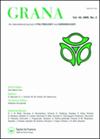58. Ammer River Valley (south-western Germany)
IF 1
4区 生物学
Q4 PLANT SCIENCES
引用次数: 0
Abstract
The pollen profile was obtained from the floodplain of Ammer River Valley, west of Tübingen in southwestern Germany. Underground water from a Triassic limestone aquifer feeds the small modern-day Ammer River, which is a tributary of the Neckar River (Schwientek et al. 2013). The climate is humid-temperate with highest air temperatures from June to August (mean 21–24 °C) and lowest temperatures during December to February (mean −1 to 0 °C). The nature reserve Schönbuch north of the Ammer River Valley is characterised by thermophilous and drought-adapted vegetation on south-facing slopes (Arnold 1986). Pleistocene and Holocene sediments cover the Ammer River Valley consisting of brown alluvial clays, Tufa, grey clays, and fluvial and colluvial gravels on top of the Middle Triassic dolostones and mudstones (Geyer et al. 1995; Heidgen et al. 2020; Martin et al. 2020). In addition, the Ammer River Valley is partly covered by nutrient-rich loess deposits. Agriculture dominates today 71% of the land cover and oak, beech, and pine trees are covering hillslopes by ∼12% (Schwientek et al. 2013). Nearby, several archaeological sites have been investigated, such as Neolithic settlements of the Lineare Bandkeramik period (6.3–6.0 cal ka BP), excavated by Krauß et al. (2020), and the Mesolithic archaeological site ‘Rottenburg-Siebenlinden’ (c. 6 km away), which revealed human occupation from 10.1–7.8 cal ka BP (Kind 2010). Sediment description and dating Two sediment cores, X039A and X039B, (48° 31′ 44.11′′ N, 08° 57′ 47.73′′ E) were taken in continuous 2 m intervals with no overlap, with core recovery of about 82% (Heidgen et al. 2020). The palynological studies concentrated on the upper 8 m from core X039B (Table I), from which 46 samples, with pollen sums between 150 and 500 arboreal pollen grains, were analysed. Pollen taxonomy follows Beug (2004). In addition to dispersed spores and pollen grains, microcharcoals > 10 μm and non-pollen palynomorphs (NPPs) were registered as well. The software TILIA (incl. CONISS) was used for constructing the pollen diagram and to determine the local pollen assemblage zones (LPAZs) (Grimm 1992a, 1992b). The chronology of core X039B is based on 14 accelerator mass spectrometry (AMS) carbon-14 (C) dates (Table II).58. 阿姆河流域(德国西南部)
花粉剖面采集于德国西南部t宾根以西的Ammer河谷漫滩。来自三叠纪石灰岩含水层的地下水为现今的Ammer河提供水源,这条河是Neckar河的一条支流(Schwientek et al. 2013)。气候属湿润温带,6月至8月气温最高(平均21-24°C), 12月至2月气温最低(平均- 1至0°C)。阿默河谷北部的自然保护区Schönbuch的特点是在朝南的斜坡上有喜热和适应干旱的植被(Arnold 1986)。更新世和全新世沉积物覆盖了阿默尔河流域,由棕色冲积粘土、凝灰岩、灰色粘土、河流和砾石组成,覆盖在中三叠统白云岩和泥岩之上(Geyer et al. 1995;Heidgen et al. 2020;Martin et al. 2020)。此外,阿默尔河谷部分地区被营养丰富的黄土覆盖。如今,农业占据了71%的土地覆盖,橡树、山毛榉和松树覆盖了约12%的山坡(Schwientek et al. 2013)。附近的几个考古遗址已经进行了调查,例如由Krauß等人(2020年)挖掘的Lineare Bandkeramik时期的新石器时代定居点(6.3-6.0 cal ka BP),以及中石器时代的考古遗址“Rottenburg-Siebenlinden”(约6公里),揭示了人类在10.1-7.8 cal ka BP (Kind 2010)的活动。X039A和X039B两个沉积物岩心位于北纬48°31′44.11”,东经08°57′47.73”,连续2 m间隔,无重叠,岩心回收率约为82% (Heidgen et al. 2020)。孢粉学研究集中在X039B岩心上部8 m处(表1),共分析了46份样品,花粉总数在150 ~ 500粒之间。花粉分类遵循Beug(2004)。除分散的孢子和花粉粒外,还观察到微炭bbb10 μm和非花粉孢粉形态(NPPs)。使用TILIA软件(包括CONISS)构建花粉图并确定局部花粉组合带(lpaz) (Grimm 1992a, 1992b)。核心X039B的年表是基于14个加速器质谱(AMS)碳-14 (C)日期(表2)。
本文章由计算机程序翻译,如有差异,请以英文原文为准。
求助全文
约1分钟内获得全文
求助全文
来源期刊

Grana
生物-植物科学
CiteScore
2.10
自引率
11.10%
发文量
23
审稿时长
>12 weeks
期刊介绍:
Grana is an international journal of palynology and aerobiology. It is published under the auspices of the Scandinavian Palynological Collegium (CPS) in affiliation with the International Association for Aerobiology (IAA). Grana publishes original papers, mainly on ontogony (morphology, and ultrastructure of pollen grains and spores of Eucaryota and their importance for plant taxonomy, ecology, phytogeography, paleobotany, etc.) and aerobiology. All submitted manuscripts are subject to initial appraisal by the Editors, and, if found suitable for further consideration, to peer review by independent, anonymous expert referees. All peer review is single blind and submission is online via ScholarOne Manuscripts.
 求助内容:
求助内容: 应助结果提醒方式:
应助结果提醒方式:


